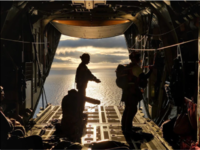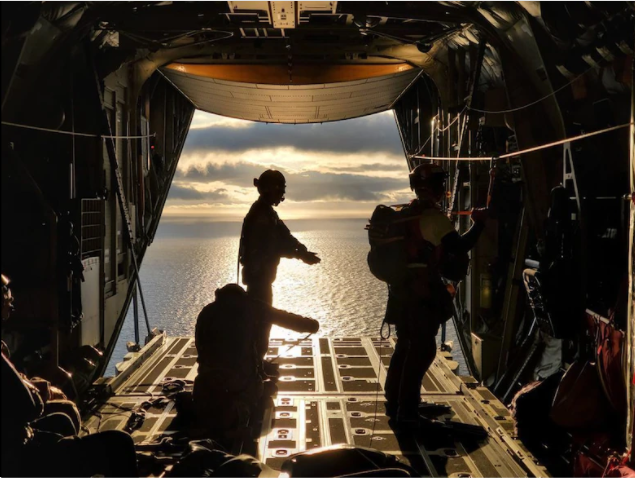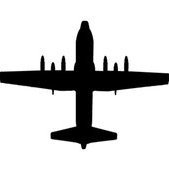

LAJES, Portugal – Fifteen Airmen from the New York Air National Guard’s 106th Rescue Wing participated in a NATO search and rescue exercise in the Azores led by the Portuguese Air Force July 27-30.
ASAREX 2021 (Advanced Search and Rescue Exercise) included elements from the National Guard, the Coast Guard, the Royal Canadian Air Force, Portugal’s Maritime Police, Border Police and Civil Protection Force, and the Portuguese Air Force.
Pararescue Airmen and an HC-130J Combat King II search and rescue plane from the 106th took part in the exercise, based at Portugal’s Air Base No. 4 at Lajes on Terceira Island. The island chain is in a key location in the Atlantic.
The Coast Guard also sent an HC-130J Hercules, and the Canadians sent a CC-130H search and rescue aircraft with Canadian Search and Rescue Technicians on board.
The Portuguese provided P-3 Orion ocean reconnaissance aircraft, the C-295M, C-130 H and UH-101 Merlin helicopters, and a destroyer, the NRP Viana Do Castelo.
“I was very impressed by the amount of resources that the Portuguese had put into this exercise,” said Master Sgt. Ryan Dush, a pararescueman from the wing’s 103rd Rescue Squadron.
The 106th was invited to the exercise because of its role in helping the Portuguese Air Force rescue injured crew members from the MV Tamar in 2017 after an explosion and fire on the vessel, wing leaders said.
Two crew members died and two others were injured. Pararescuemen from the 106th parachuted into the ocean more than 1,000 miles out at sea to provide medical care for the injured sailors, then worked with the Portuguese Air Force to rescue them when the ship neared the Azores.
The training scenarios for ASAREX 2021 provided new challenges for the 106th’s Airmen. Instead of looking for a ship, they had to locate a 20-man life raft.
First, two pararescuemen boarded the HC-130 Combat King II at F.S. Gabreski Air National Guard Base on Long Island and took a six-hour flight toward the Azores.
Once on-site, the crew had to find the target life raft and the two “survivors” on board. Once the raft was located, the aircrew coordinated with the pararescuemen for the jump out of the plane.
Dush, acting as the drop zone safety officer, was on the Portuguese naval destroyer, ensuring the area was safe for the pararescuemen to parachute into the water.
Then the pararescuemen simulated medical treatment of the survivors and coordinated with a rescue boat for transport to safety.
For the aircrew flying the 106th HC-130J during the rescue, this exercise was an opportunity to practice coordinating the pararescuemen jumping and deploying an MA-2 Sea Rescue Kit, said Maj. Ian D’Amico, the HC-130 pilot for the mission.
The kit includes two 20-man life rafts with 210 feet of rope, medical supplies and emergency radio equipment designed to be dropped from an aircraft upwind from the survivor in the water. The wind and current push the rope and rafts toward the survivor, bracketing them and allowing them to pull themselves to either life raft.
“We don’t get to deploy MA-2 Kits often, so this was an awesome opportunity for our aircrew flight equipment members to package them and for us to deploy them,” said D’Amico, a 102nd Rescue Squadron pilot.
“It was perfectly executed. We dropped the package from 200 feet and it landed 50 feet upwind from the subject and it bracketed them like designed.”
D’Amico said the exercise was excellent training.
“Training our own long-range rescue capabilities and coordinating search and rescue with other countries was a huge opportunity for us,” D’Amico said. “When it comes to search and rescue, it’s all about readiness.”
Ultimately, the exercise was an opportunity to exchange experiences and knowledge on a multinational level, according to Master Sgt. Matthew Zimmer, a 103rd Rescue Squadron pararescueman and jumpmaster during the exercise.
“It’s really valuable to be able to simulate a real-world scenario and work jointly with other countries involved in search and rescue,” Zimmer said.
View original article: New York Air Guard joins NATO search and rescue exercise > Air National Guard > Article Display (af.mil)


Recommended Comments
There are no comments to display.
Join the conversation
You can post now and register later. If you have an account, sign in now to post with your account.